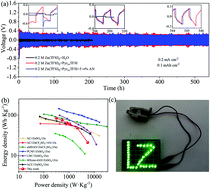Developing high voltage Zn(TFSI)2/Pyr14TFSI/AN hybrid electrolyte for a carbon-based Zn-ion hybrid capacitor †
Abstract
Aqueous Zn-ion hybrid capacitors (ZIHCs), integrating the typical characteristics of Zinc ion batteries and supercapacitors, have become a promising candidate to replace or supplement lithium-ion energy storage technology. However, the narrow operating voltage window and the instability of the Zn/electrolyte interface caused by aqueous solvents have become a great challenge for practical applications. Here, we developed a new type of hybrid electrolyte (Zn(TFSI)2/[[Pyr14TFSI]3]16/[AN]4) based on the organic solvent (AN) combined with ionic liquid (Pyr14TFSI) and Zn salt (Zn(TFSI)2). This non-flammable electrolyte benefited from the synergistic advantages of Pyr14TFSI and AN, and could output a wide electrochemical window (3.32 V vs. Zn/Zn2+) and good compatibility with metallic Zn, while possessing excellent wettability. Theoretical and experimental results further reveal that such superb performance originates from the change of Zn coordination environment. Consequently, the constructed ZIHC displays a stable cycling performance (10 000 cycles at 5 A g−1 without significant capacity fade) and a high operating voltage of 2.1 V. This newly developed electrolyte, which solves the conventional interface problem and improves the voltage window, will promote the development of ZIHCs.



 Please wait while we load your content...
Please wait while we load your content...